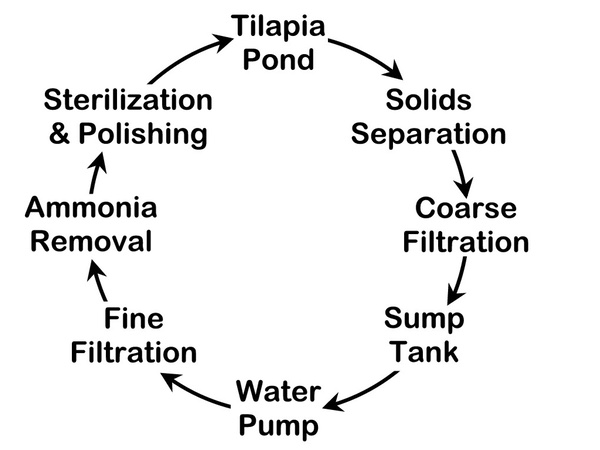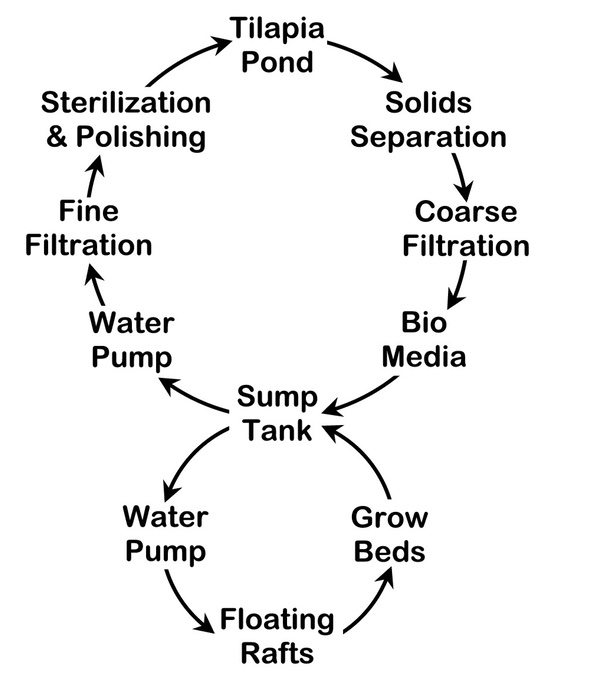Tilapia farming guide - Part 2
Tilapia farming systems
Tilapia farming is nothing more than the act of raising tilapia in captivity until they reach the desired harvest size. As long as the tilapia farmer's goals are attained, the farm is successful; and there's no arguing with success. You may disagree with the farmer's methods, but that doesn't make them wrong. Every farm is different, every farmer has their own goals, and every tilapia farm uses different methods.
Of course, if one of the tilapia farmer's goals is to raise tilapia at a cost on par with the grocery store, or for re-sale at a competitive price, success may prove to be more elusive. This is because, while tilapia farming is fairly straightforward, raising tilapia economically requires an in-depth study of all of the available resources and methods. In some situations, it may not be possible for a tilapia farming operation to meet its goals; while in others, making a few minor tweaks to a process or two may be all that's necessary. For the purposes of this guide, we will assume that you want to be as efficient as possible. For the sake of brevity, we will only mention those processes that meet this criteria. In almost every case, there are other methods available, but to our knowledge, none of them are more cost effective than the methods that we cover here.
If you haven't already read part one of this tilapia farming guide, we highly suggest that you go back and read it before continuing. We will not be repeating concepts that have already been introduced, so some of this information may seem incomplete. For part two, we are going to build a hypothetical tilapia farm from scratch. We will present all of the cost effective options, but ultimately, in order to move forward, decisions will have to be made. Please feel free to choose the alternatives to fulfill your own needs; the end results will be the same.
The water cycle

The diagram above shows the cycle of water in a recirculating aquaculture system. The water leaves the tilapia pond and flows into the solids separation unit. After heavy solids are separated, the water continues on through a coarse filtration stage. Once the large neutrally buoyant particles are captured, the water continues to the lowest part of the system, known as the sump tank. Until this point, all of the water flow has been achieved using gravity or hydrostatic pressure. The reason for this is only obvious to an experienced tilapia farmer, however we wouldn't be much of a guide if we didn't share a few secrets.
- Tilapia poop is far easier to capture when it is in large pieces. By using gravity or hydrostatic pressure, the poop remains intact. If you use a water pump before these filtration steps, you will severely reduce their effectiveness.
Critical Point: Any tilapia farming diagram that shows water being pumped from the tilapia pond, or places a pump anywhere in front of the solids separator or coarse filtration unit, is ill-conceived. And yes, there are college course materials that make this mistake.
Now under pressure, the water is pumped from the sump tank through a fine particle filter to remove tiny solids down to double-digit micron size. After the fine particles are removed, the water passes through an ammonia removal stage where ammonia gas is either absorbed or removed. Finally, the water passes through some optional polishing and sterilization stages. These steps are typically used on an as-needed basis, however some steps, such as ultraviolet sterilization, can be permanently implemented. The water is then returned to the pond, to start its journey again.
Optional: It is also possible to remove ammonia gas from the water using aeration prior to entering the sump, or in a recirculating fashion from and back to the sump. This method injects a high volume of air at the bottom of a water column creating vigorous aeration that essentially blows the ammonia gas out of the containment vessel, leaving the water behind.
The water cycle for aquaponics

To convert our recirculating water cycle diagram into aquaponics, we have to omit the ammonia removal step, and add bio media before the sump. Then we simply pump water from the sump, through the growing beds, and let it drain back into the sump. This isn't the only way to plumb an aquaponics system, it's how we do it. This flow keeps the solid wastes to a minimum inside of our grow beds, and reduces our dependence on the grow beds as bio media. This design also allows us to disconnect the aquaculture side from the hydroponics side at any time, for any reason. It should also be noted that the placement of floating rafts and growing beds in the water flow does not matter. Your own system may place the growing beds before the floating rafts. In our case, the slope of our property made the decision for us.
Critical Point: Remember, you are running an aquaponics system, not a sewage treatment plant. Fish poop is still poop. A bag of manure, doesn't come straight from the cows rear end. It's been composted and mixed with other materials to be transformed into fertilizer. Allowing animal feces to come in contact with plants is how we ended up with E. coli on soil-based farms. Look it up for yourself. Always use some sort of solids separator or other filtration method to prevent raw fish poop from entering your plant grow beds.
Plant-centric vs. fish-centric
When you first discovered aquaponics, you probably fell into one of two schools. You either thought about all of the vegetables that you were going to grow using free fish waste as a fertilizer; or you thought about all the fish that you were going to raise, while using plants to help keep the water clean. Basically, you cared more about the vegetables, or more about the fish. Very few aquaponic growers are equally concerned about both, and even fewer strive to maximize their output of fish and vegetables simultaneously.
This imbalance is most evident in aquaponics classrooms, where fish output is kept to the minimum required to serve the needs of the plants; or aquaponic systems designs that equate the number of fish that can be raised, to the square footage of the vegetable growing beds. The whole idea of balance in aquaponics is malarkey. I suspect it was made up by the early pioneers of aquaponics, who let raw fish sewage flow into their grow beds, killing their plants, then trying again with fewer fish, slowly adding more and more until they started killing plants again, eventually finding "the balance". Unfortunately, nebulous concepts like this continue to blur what would otherwise be considered common sense. Of course, I wasn't there when the first people started using words like harmony and balance to describe aquaponics, so I'm just guessing.
The truth be told, I started out by raising vegetables in a hydroponics system, and raising fish in an aquaculture system. They were two separate things altogether. Both designed and operated for the maximum output in their available space. So when I created my first aquaponics system, all I had to do was connect the sump from my pond to the reservoir for my plants and voila, I had an aquaponics system. Because I was never encumbered with the idea that I had to achieve some balance, I moved forward with blissfully ignorant success. I grew as many plants and raised as many fish as I wanted.
to be continued...
